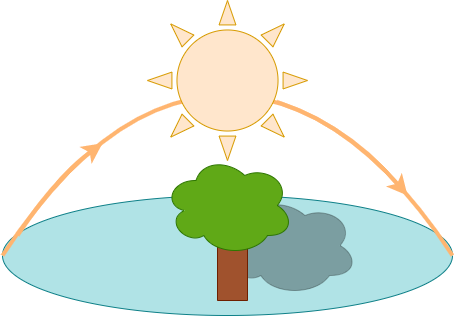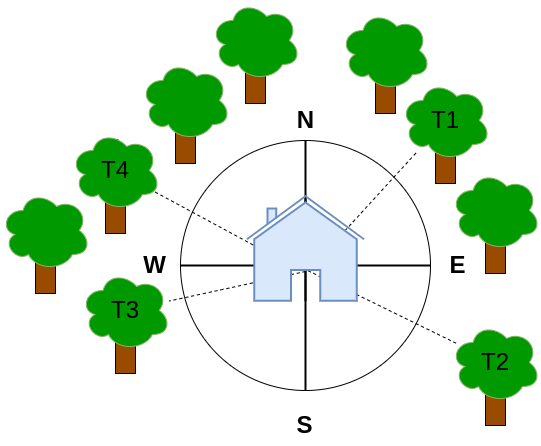
In this post, we let away solar panels. Instead, we discuss about optimizing energy input This can be done using optimal house orientation or using the shade of other elements. Tree are almost free (but take time to grow), so they are good natural candidate to this function.
If you haven’t read them, you can check the other articles of this series:
In summer, the sunlight provides a lot of energy, which is often converted into heat. To avoid getting too much energy into a house, there are multiple strategies:
Thermal insulation is widely discussed in many books, blog, forum, so we won’t talk about it.
House orientation and shading are two strategies that cost nothing (almost), and allow to reduce the amount of sunlight received by a house in summer.
By oral knowledge, you may know that the best orientation of a house is facing south. However, a house has one roof, one floor, and 4 faces, so all houses are facing south unless for terraced houses.
What we really mean by “south” is one of the two largest faces must be south-oriented. The other largest face is then facing north, and the building is along an East-West line.
To understand why the configuration with a large south face is interesting, we have to go back to our sun angles:
It is interesting to know about this fact, before buying/building a house, or orienting your van.
However, when built, you cannot turn your house 90°.
When you cannot turn your house, you can create shade. Trees take time to growth, but they are almost free to run.
Trees must not be too close from the house, otherwise roots may affect the basement, and leaves may clog the rain gutters. And not too far, otherwise you don’t get the desired effect.
So, I created a simulator: given the sun angle, tree height (check on books the typical height of the tree you want to grow), wall height, you can find the optimal distance of the tree. This simulator can be used both ways:
Remember the first post, there are two angles:
Your house will be affecte by different shade at different moment.

For instance, the shade of tree T1 will only benefit in the morning, where the sun has a specific angle, which is different from T2 or T3.
For each tree, we need first to look at the positional angle of the tree in the earth plane, with the house as the center, to check when the shade would benefit, and then, given this hour, check the sun angle in summer.
Trees planted in the north do not provide any shade, so they have no impact. Trees directly on the south are not recommended because even if they don’t have leaves in winter, they would provide shade in winter, reducing sunlight exposure.
To know when a tree can produce a shade on your house, you need measure the HRA angle of the tree for finding the hour when the shade may coverthe house:
\[HRA(h) = \omega(12 - h)\]with \(\omega=15°/\text{hour}\) and \(h\) the current time in hour.
Next, knowing the hour at which the tree can make a shade, you need to look at the elevation angle:
Now, you just have to play with this tool given the elevation angle to know if the tree will shade your house:
Note: It is commonly said that the sun rises in the east and sets in the west. This is an average. In summer, the sun rises N-E and sets N-W, while in winter rises almost S-E and sets S-W, unless in the equator.
If you just want shade, you can also build a wall or make a giant sun-shield.
Trees have other benefits:
>> You can subscribe to my mailing list here for a monthly update. <<